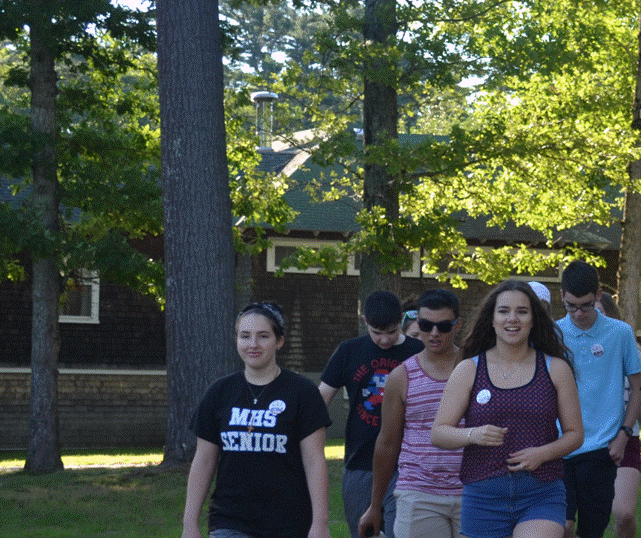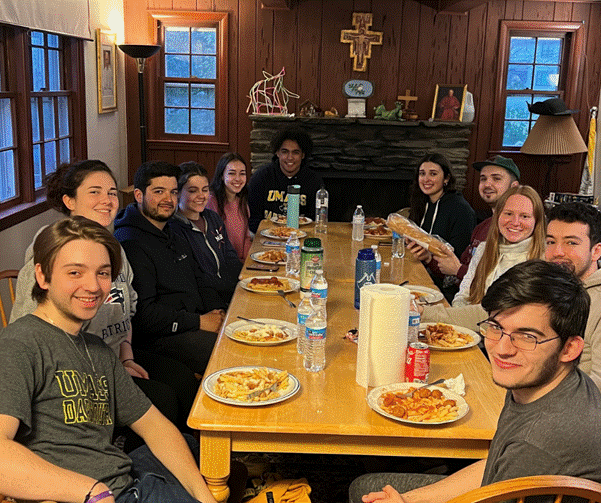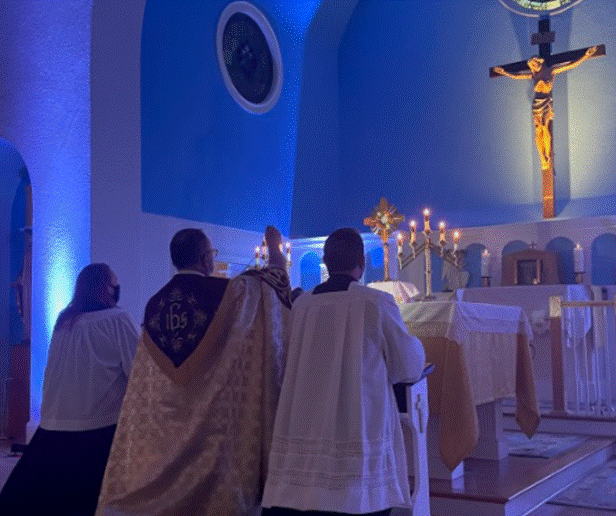David Carvalho | Diocese of Fall River

Photo: Diocese of Fall River
In ministry, it’s common to ask, “What should we teach this year?” or “What events should we plan?” But an even more foundational question is often overlooked: Where are the people we serve on their journey of faith—and what do they actually need next?
Just as teachers create individualized learning plans (IEPs) to accommodate different learning styles and needs, effective ministry requires a similar mindset. Not everyone is at the same place spiritually, and a one-size-fits-all approach may leave many disconnected. To truly help people encounter Christ, we need to understand their spiritual location and know the right way to walk with them—step by step—toward intentional discipleship.
Ministry Isn’t One-Size-Fits-All
In education, individualized learning plans (IEPs) are designed to help students reach the same academic goals as their peers through personalized approaches based on their specific needs. Effective ministry requires a similar mindset in sense that if we want people in our parishes to grow in faith, we must first understand where they are spiritually. Teaching someone about the fruits of the Holy Spirit, for example, won’t bear fruit if they don’t yet believe in God. Before we lead someone to deeper discipleship, we must earn their trust and introduce them to Jesus in a way that resonates.
This is where the Church’s vision of the baptismal catechumenate becomes essential. While this refers to the journey adults take to enter into the Church and be fully initiated, it is also the source of inspiration for all evangelization and catechesis. To this end, we can refer to it as a discipleship pathway. It is thus a model for how people move from initial curiosity to becoming active, engaged disciples of Christ in general. Understanding and using this model can transform our formation efforts and lead to real, lasting conversion.
The Five Stages of the Discipleship Pathway
The discipleship pathway outlines five distinct stages that most people follow as they come to know and follow Jesus:
- Pre-Evangelization
At this stage, a person has little or no trust in Jesus or the Church. They may be indifferent or even hostile toward religion. Our task is to build initial trust, foster curiosity, and till the soil of their hearts. This is not the time for deep theological discussion, but for kindness, openness, and relational witness. - Evangelization
Once trust is built, we can begin to share the kerygma—the basic message of the Gospel: that there is a loving God, that sin broke our relationship with Him, that Jesus died and rose to restore that relationship, and that we are invited to respond in faith and love. This is the “why” behind everything we do in ministry. - Conversion
This is the moment of metanoia—a Greek word meaning “to repent” or “turn around.” It’s the point when a person says “yes” to Jesus and decides to follow Him. They put Christ at the center of their life. Conversion isn’t the end of the journey; it’s the turning point. - Discipleship
Now committed to Christ, the person begins to learn what it means to follow Him day by day. This is where deeper formation takes place—through prayer, Scripture, the sacraments, service, and community. - Apostleship
In this final stage, the disciple becomes a missionary. They’re not only learning and growing in their own faith, but helping others begin their journey. They may serve as leaders in ministry, mentors, or evangelists in their families and communities.
The Road to Emmaus: A Model of the Pathway
One of the clearest biblical examples of the discipleship pathway is found in the story of the Road to Emmaus (Luke 24:13–35). After the crucifixion, two confused and heartbroken disciples walk away from Jerusalem, uncertain about what to believe.
Jesus meets them on the road—not with immediate answers, but with questions. He listens. He walks with them. He starts where they are. This is pre-evangelization.
Then He begins to explain the Scriptures and connect the events of the crucifixion to God’s greater plan. This is evangelization.
Later, as they sit together at dinner, Jesus breaks the bread—and their eyes are opened. They realize who He is. This is their moment of conversion.
Immediately, they get up, turn around, and rush back to Jerusalem. This physical act of turning around mirrors their spiritual transformation—discipleship in motion.
Eventually, these same disciples would go on to proclaim the Gospel to others—stepping into apostleship.
Minister Like Jesus: Walk the Road With Them
Jesus didn’t start the conversation by declaring His identity or reciting doctrine. He began by walking with them in the wrong direction. He patiently earned their trust, answered their questions, and met them with compassion.
In ministry today, we’re called to do the same. We must ask:
- Where are the people I serve on the discipleship pathway?
- Are they ready to hear the Gospel?
- Do they need healing or trust before formation?
- Have they already encountered Jesus and need help growing as disciples?
When we tailor our ministry to each stage of the journey, we stop treating everyone the same and start serving them more effectively.
Accompaniment With Purpose
It’s easy to think of accompaniment as simply “being there” for someone. But true accompaniment has direction. We walk with people not just for the sake of walking—but to help them encounter Christ and say “yes” to Him.
Jesus didn’t stay in Emmaus. He led His disciples back to Jerusalem and eventually to the upper room at Pentecost. Likewise, we’re not called to just walk—we’re called to lead people to the fullness of life in Christ.
Applying This to Your Ministry
Here are a few ways to begin integrating the discipleship pathway into your ministry this year:
- Assess your audience. Use relational conversations, surveys, or small group discussions to understand where people are spiritually.
- Adapt your approach. Don’t offer deep catechesis to someone who hasn’t yet encountered the Gospel or doesn’t believe Jesus is God. Start by building trust and testimony.
- Invest in pre-evangelization. Considering this, incorporate environments of welcome and opportunities at the onset that lend themselves to fostering community and belonging help break down walls before sharing the kerygma.

Photo: Diocese of Fall River
- Foster Openness and Arouse Curiosity
Let people ask questions and recognize that you can be a trusted source to discuss doubts. This way, we can help them foster openness and arouse curiosity for uncovering the very real answers the Catholic faith provides for their questions. Show them the faith by how you live and treat them. Be the first “Bible” they “read” before simply handing them one.
- Proclaim the kerygma often. Don’t assume everyone knows the “why” of our faith. Keep returning to it and make it compelling.
Speak of how you were before and after following Christ. Speak to the challenges they name with examples of how Christ was present in darknesses you faced.
If individuals can’t see how God is working in the midst of their pain, sin, or lives in general, they won’t fully understand a critical part of the kerygma: that God is not silent or doesn’t care, but rather Jesus’ death and resurrection is God actively responding to the problem of evil and a “messed up” world.
Questions of suffering, evil, and existence are real questions that don’t deserve watered down answer. And our own witness can bear great dividends in helping them to see the answers at work.
- Think systematically in how you order what you offer
Just as you begin intentionally with opportunities to build relationships and trust, think in terms of what can be done next that is kerygmatic in nature. How can you intentionally place opportunities, such as retreats, small groups and small group series on initial questions in the faith, at the beginning phases of someone’s faith journey with you?

Photo: Diocese of Fall River
- Take them Deeper
Specifically, take them deeper into the heart of God. Incorporate intentional times of prayer and Adoration. Celebrate the Sacraments. Don’t let someone remain in the shallow end. While that is where they may get in, the point of a path is you keep journeying. But help them get into the “deep end”. Go with them.
Consider inviting individuals who have done this to a next step, such as a larger Catholic conference, day event or outreach opportunity.
- Walk with purpose. Know that your goal isn’t just attendance or programming—it’s transformation. Keep that purpose at the forefront.
Conclusion: Know the Way, Show the Way
If we want our parishes to be places of transformation, not just information, we must minister like Jesus did on the road to Emmaus. We must recognize where people are on their journey, meet them there with love and patience, and guide them step by step toward deeper discipleship.
The ultimate goal is to help every person say yes to Jesus—and to keep saying yes, day by day, as they grow into saints.
Watch the video version of this article “Know the Right Way to Go” at: https://www.youtube.com/@equipcatholics